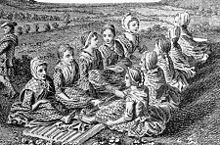Fulling

Engraving of Scotswomen singing a waulking song while walking or fulling cloth, c. 1770.
Fulling, also known as tucking or walking (spelled waulking in Scotland), was a step in woollen clothmaking which involves the cleansing of cloth (particularly wool) to eliminate oils, dirt, and other impurities, and to make it thicker. The worker who does the job is a fuller, tucker, or walker,[1] all of which have become common surnames. The Welsh word for a fulling mill is pandy,[2] which appears in many place-names, for example Tonypandy ("fulling mill lea").
Contents
1 Process
1.1 Scouring
1.2 Thickening
2 Fulling mills
3 History
4 See also
5 References
6 Bibliography
7 External links
Process
Fulling involves two processes: scouring and milling (thickening). Originally, fulling was carried out by the pounding of the woollen cloth with a club, or the fuller's feet or hands. In Scottish Gaelic tradition, this process was accompanied by waulking songs, which women sang to set the pace. From the medieval period, however, fulling was often carried out in a water mill, followed by stretching the cloth on great frames known as tenters, to which it is attached by tenterhooks. It is from this process that the phrase being on tenterhooks is derived, as meaning to be held in suspense. The area where the tenters were erected was known as a tenterground.
Scouring
In Roman times, fulling was conducted by slaves working the cloth while ankle deep in tubs of human urine. Urine was so important to the fulling business that it was taxed. Stale urine, known as wash, was a source of ammonium salts and assisted in cleansing and whitening the cloth. By the medieval period, fuller's earth had been introduced for use in the process. This is a soft clay-like material occurring naturally as an impure hydrous aluminium silicate. It was used in conjunction with wash. More recently, soap has been used.
Thickening
The second function of fulling was to thicken cloth by matting the fibres together to give it strength and increase waterproofing (felting). This was vital in the case of woollens, made from carding wool, but not for worsted materials made from combing wool. After this stage, water was used to rinse out the foul-smelling liquor used during cleansing. Felting of wool occurs upon hammering or other mechanical agitation because the microscopic barbs on the surface of wool fibres hook together, somewhat like Velcro.
Fulling mills

A fulling mill from Georg Andreas Böckler's Theatrum Machinarum Novum, 1661
From the medieval period, the fulling of cloth often was undertaken in a water mill, known as a fulling mill, a walk mill, or a tuck mill, and in Wales, a pandy. In these, the cloth was beaten with wooden hammers, known as fulling stocks or fulling hammers. Fulling stocks were of two kinds, falling stocks (operating vertically) that were used only for scouring, and driving or hanging stocks. In both cases the machinery was operated by cams on the shaft of a waterwheel or on a tappet wheel, which lifted the hammer.
Driving stocks were pivoted so that the foot (the head of the hammer) struck the cloth almost horizontally. The stock had a tub holding the liquor and cloth. This was somewhat rounded on the side away from the hammer, so that the cloth gradually turned, ensuring that all parts of it were milled evenly. However, the cloth was taken out about every two hours to undo plaits and wrinkles. The 'foot' was approximately triangular in shape, with notches to assist the turning of the cloth.
History
There are several Biblical references to fulling (2 Kings 18:17; Isaiah 7:3 and 36:2; Malachi 3:2; Mark 9:3). Prior to this, at least one reference appears in the speeches of Lysias, written in Athens during the 5th century BC. By the time of the Crusades in the late eleventh century, fulling mills were active throughout the medieval world.[3] They appear to have originated in 9th or 10th century in Europe. The earliest known reference to a fulling mill in France, which dates from about 1086, was discovered in Normandy.[4]
See also
- Bleachfield
- List of laundry topics
- Posting (laundering process)
References
^ Jones, Gareth Daniel Rhydderch of Aberloch, reproduced from The Western Mail July 17, 1933 accessed at "Archived copy". Archived from the original on 2007-03-11. Retrieved 2007-04-07.CS1 maint: Archived copy as title (link).mw-parser-output cite.citation{font-style:inherit}.mw-parser-output .citation q{quotes:"""""""'""'"}.mw-parser-output .citation .cs1-lock-free a{background:url("//upload.wikimedia.org/wikipedia/commons/thumb/6/65/Lock-green.svg/9px-Lock-green.svg.png")no-repeat;background-position:right .1em center}.mw-parser-output .citation .cs1-lock-limited a,.mw-parser-output .citation .cs1-lock-registration a{background:url("//upload.wikimedia.org/wikipedia/commons/thumb/d/d6/Lock-gray-alt-2.svg/9px-Lock-gray-alt-2.svg.png")no-repeat;background-position:right .1em center}.mw-parser-output .citation .cs1-lock-subscription a{background:url("//upload.wikimedia.org/wikipedia/commons/thumb/a/aa/Lock-red-alt-2.svg/9px-Lock-red-alt-2.svg.png")no-repeat;background-position:right .1em center}.mw-parser-output .cs1-subscription,.mw-parser-output .cs1-registration{color:#555}.mw-parser-output .cs1-subscription span,.mw-parser-output .cs1-registration span{border-bottom:1px dotted;cursor:help}.mw-parser-output .cs1-ws-icon a{background:url("//upload.wikimedia.org/wikipedia/commons/thumb/4/4c/Wikisource-logo.svg/12px-Wikisource-logo.svg.png")no-repeat;background-position:right .1em center}.mw-parser-output code.cs1-code{color:inherit;background:inherit;border:inherit;padding:inherit}.mw-parser-output .cs1-hidden-error{display:none;font-size:100%}.mw-parser-output .cs1-visible-error{font-size:100%}.mw-parser-output .cs1-maint{display:none;color:#33aa33;margin-left:0.3em}.mw-parser-output .cs1-subscription,.mw-parser-output .cs1-registration,.mw-parser-output .cs1-format{font-size:95%}.mw-parser-output .cs1-kern-left,.mw-parser-output .cs1-kern-wl-left{padding-left:0.2em}.mw-parser-output .cs1-kern-right,.mw-parser-output .cs1-kern-wl-right{padding-right:0.2em} June 19, 2006
^ Arnold, James (1968). "Weaving". The Shell Book of Country Crafts. John Baker (Publishers) Ltd. pp. 213–215.
^ Thomas Woods (2005), "How the Catholic Church Built Western Civilization", How the Monks Saved Civilization 33
^ J. Gimpel, The Medieval Machine (2nd ed., Pimlico, London 1992 repr.), 14.
Bibliography
"full". Online Etymology Dictionary. Retrieved June 30, 2005.- E. K. Scott, "Early Cloth Fulling and its Machinery", Trans. Newcomen Soc. 12 (1931), 30–52.
- E. M. Carus-Wilson, "An Industrial Revolution of the Thirteenth Century", Economic History Review, Old Series, 11(1) (1941), 39–60.
- Reginald Lennard, "Early English Fulling Mills: additional examples", Economic History Review, New Series, 3(3) (1951), 342–343.
- R. A. Pelham, Fulling Mills (Society for the Protection of Ancient Buildings, (mills booklet 5), c. 1958)
- A. J. Parkinson, "Fulling mills in Merioneth", J. Merioneth Hist. & Rec. Soc. 9(4) (1984), 420–456.
- D. Druchunas Felting, Vogue Knitting, The Basics, Sixth & Spring Books, NY. (2005); p. 10.
External links
 The dictionary definition of tenter at Wiktionary
The dictionary definition of tenter at Wiktionary


